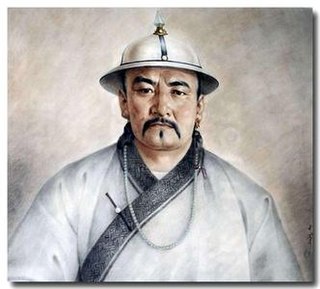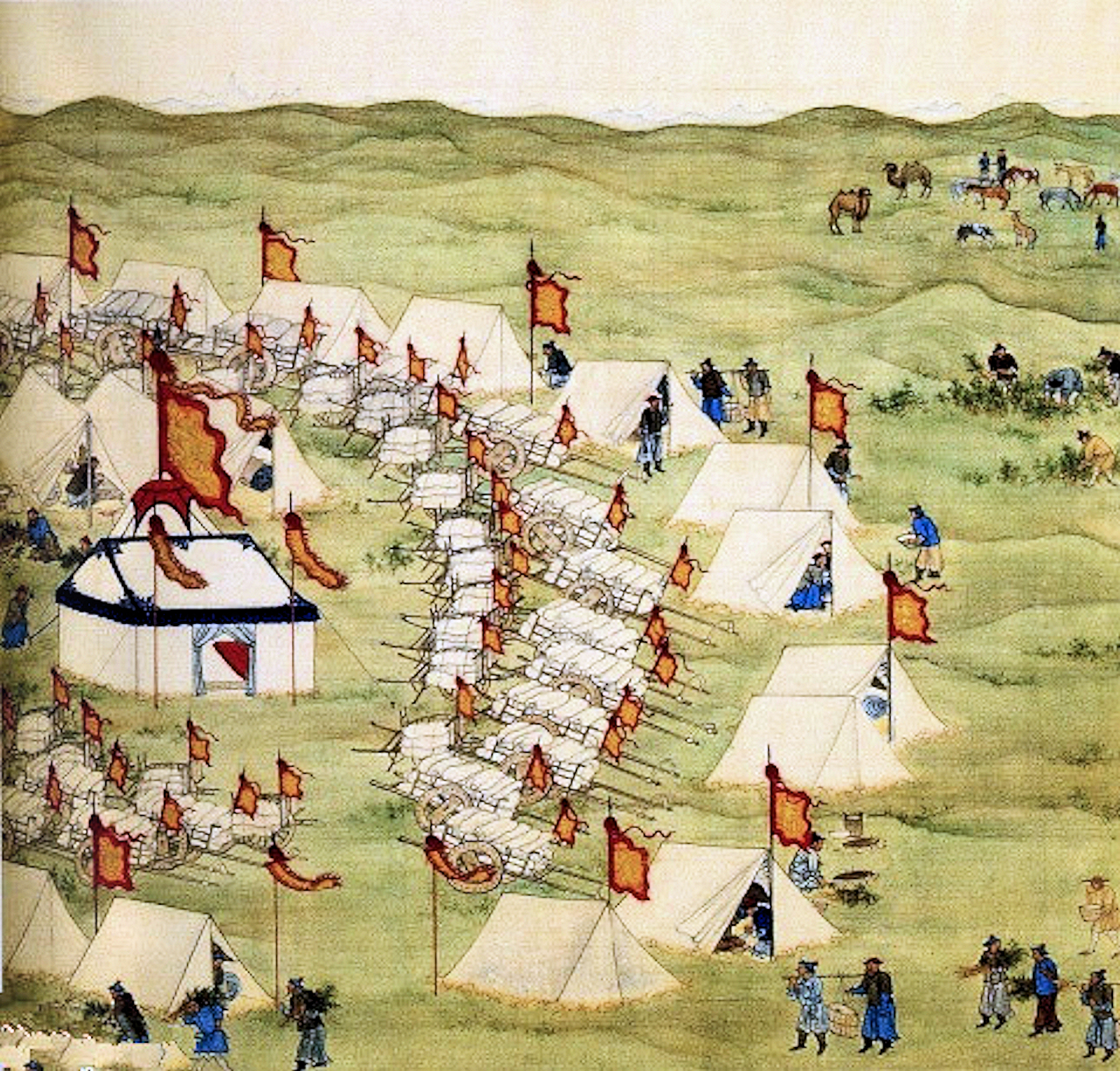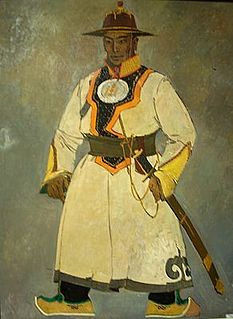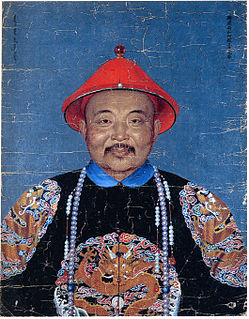
The Kangxi Emperor, given name Xuanye, was the third Emperor of the Qing dynasty, and the second Qing emperor to rule over China proper.

The Dzungar Khanate, also written as the Zunghar Khanate, was an Inner Asian khanate of Oirat Mongol origin. At its greatest extent, it covered an area from southern Siberia in the north to present-day Kyrgyzstan in the south, and from the Great Wall of China in the east to present-day Kazakhstan in the west. The core of the Dzungar Khanate is today part of northern Xinjiang, also called Dzungaria.

Choros Erdeniin Galdan was a Dzungar-Oirat Khan of the Dzungar Khanate. As fourth son of Erdeni Batur, founder of the Dzungar Khanate, Galdan was a descendant of Esen Taishi, the powerful Oirat Khan of the Northern Yuan dynasty who united the western Mongols in the 15th century. Galdan's mother Yum Aga was a daughter of Güshi Khan, the first Khoshut-Oirat King of Tibet.

Öndör Gegeen Zanabazar was the sixteenth Jebtsundamba Khutuktu and the first Bogd Gegeen or supreme spiritual authority, of the Gelugpa lineage of Tibetan Buddhism in Outer Mongolia.
Tsewang Rabtan was a Choros-Oirat prince and the Khong Tayiji of the Dzungar Khanate from 1697 until his death in 1727. He was married to Lha-bzang Khan's sister.
Galdan Tseren (?–1745) was a Choros-Oirat prince and the Khong Tayiji of the Dzungar Khanate from 1727 until his death in 1745.

Queen Anu or Lady Anu was a queen consort who led warriors into battle at the founding of the Dzungar Khanate in the late 17th century.

Mongolia under Qing rule was the rule of the Qing dynasty over the Mongolian steppe, including the Outer Mongolian 4 aimags and Inner Mongolian 6 leagues from the 17th century to the end of the dynasty. "Mongolia" here is understood in the broader historical sense. The last Mongol Khagan Ligden saw much of his power weakened in his quarrels with the Mongol tribes, was defeated by the Manchus, and died soon afterwards. His son Ejei Khan gave Hong Taiji the imperial authority, ending the rule of Northern Yuan dynasty then centered in Inner Mongolia by 1635. However, the Khalkha Mongols in Outer Mongolia continued to rule until they were overrun by the Dzungars in 1690, and they submitted to the Qing dynasty in 1691.

The Northern Yuan was a dynastic regime ruled by the Mongol Borjigin clan based in the Mongolian Plateau. It operated as a rump state after the collapse of the Yuan dynasty of China in 1368 and lasted until its conquest by the Jurchen-led Later Jin dynasty in 1635. The Northern Yuan dynasty began with the end of Yuan rule in China proper and the retreat of the Yuan remnants led by Toghon Temür to the Mongolian steppe. This period featured factional struggles and the often only nominal role of the Great Khan.

Hexigten Banner is a banner of Inner Mongolia, China under the jurisdiction of Chifeng, bordering Hebei province to the south. In 1690 the Battle of Ulan Butung between Qing and Dzungar forces took place here.
Changning (help·info), formally known as Prince Gong, was a Manchu prince of the Qing dynasty. He was born in the Aisin Gioro clan as the fifth son of the Shunzhi Emperor, making him a half-brother of the Kangxi Emperor.
Fuquan (Manchu: ᡶᡠᠴᡳᠣᠸᠠᠨ; Möllendorff: fuciowan; Abkai: fuqiuwan, formally known as Prince Yu, was a Manchu prince of the Qing dynasty. He was the second son of the Shunzhi Emperor and a half-brother of the Kangxi Emperor.

The Battle of Jao Modo also known as the Battle of Zuunmod, was fought on June 12, 1696 on the banks of the upper Terelj river 60 kilometres (37 mi) east of the modern-day Mongolian capital Ulaanbaatar. A Dzungar-Mongol army under the command of Galdan Boshugtu Khan was defeated by Qing armies personally led by the Kangxi Emperor. This decisive Qing victory in the early stages of the Dzungar–Qing Wars (1687–1758) effectively incorporated Khalkha Mongolia under Qing rule and relegated Dzungar Mongol forces to Inner Asia until they were finally defeated in 1758.
The Battle of Ulan Butung was fought on 3 September 1690 between the forces of the Qing dynasty and those of the Dzungar Khanate. When attacked by the superior Qing army, the Dzungars formed a camel wall to defend their camp and defeated Qing assaults on their right flank, but were driven back on the left. They were able to withdraw into the wooded hills behind their camp in good order. The Qing commander, Fuquan, reported it as a victory, but was discredited by political opponents.

The Dzungar–Qing Wars (1687–1757) were a decades-long series of conflicts that pitted the Dzungar Khanate against the Qing dynasty of China and their Mongolian vassals. Fighting took place over a wide swath of Inner Asia, from present-day central and eastern Mongolia to Tibet, Qinghai, and Xinjiang regions of present-day China. Qing victories ultimately led to the incorporation of Outer Mongolia, Tibet and Xinjiang into the Qing Empire that was to last until the fall of the dynasty in 1911–1912, and the genocide of much of the Dzungar population in conquered areas.

Amursana was an 18th-century taishi or prince of the Khoit-Oirat tribe that ruled over parts of Dzungaria and Altishahr in present-day northwest China. Known as the last great Oirat hero, Amursana was the last of the Dzungar rulers. The defeat of his rebel forces by Qing dynasty Chinese armies in the late 1750s signaled the final extinction of Mongol influence and power in Inner Asia, ensured the incorporation of Mongol territory into the Qing Chinese Empire, and brought about the Dzungar genocide, the Qing Emperor's "final solution" to China's northwest frontier problems.

Tibet under Qing rule refers to the Qing dynasty's rule over Tibet from 1720 to 1912. Tibet was under Khoshut Khanate rule from 1642 to 1717, with the Khoshuts conquered by Dzungar Khanate in 1717, and the Dzungars subsequently expelled by Qing in 1720. The Qing emperors appointed resident commissioners known as Ambans to Tibet, most of them are ethnic Manchus, who reported to the Lifan Yuan, a Qing government body that oversaw the empire's frontier. Tibet under Qing rule retained a degree of political autonomy under the Dalai Lamas nonetheless.

The Qing dynasty in Inner Asia was the expansion of the Qing dynasty's realm in Inner Asia in the 17th and the 18th century AD, including both Inner and Outer Mongolia, Manchuria, Tibet, Qinghai and Xinjiang.

Dawachi was the last khan of the Dzungar Khanate from 1753 until his defeat at the hands of Qing and Mongol forces at Ili in 1755.














